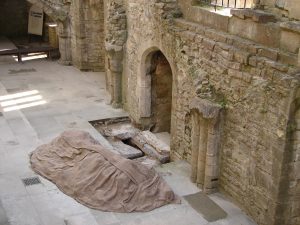 A Lady Chapel, dedicated to “Our Lady”, the Virgin Mary, in honour of the mother of Jesus, is a prominent chapel in all medieval English cathedrals and major churches. The Lady Chapel of a Christian church not only speaks to a separate sacred space for worship, in every case it contains a separate altar. Usually, the Lady Chapel is the largest of the chapels in a church and is located on the east end of the building.
A Lady Chapel, dedicated to “Our Lady”, the Virgin Mary, in honour of the mother of Jesus, is a prominent chapel in all medieval English cathedrals and major churches. The Lady Chapel of a Christian church not only speaks to a separate sacred space for worship, in every case it contains a separate altar. Usually, the Lady Chapel is the largest of the chapels in a church and is located on the east end of the building.
Lady Apollonia visits the Lady chapel at the east end of Exeter Cathedral in Plague of a Green Man, the 2nd of the Lady Apollonia West Country Mysteries. The story tells the reader that she noted another of Exeter’s foliate faces on a roof boss in that chapel and was curious why such a carving should be included in a holy place.
Exeter’s Lady Chapel dates to the 13th century when the Gothic rebuilding of the cathedral began. It now houses several historic tomb effigies including that of Leofric, who was bishop when the cathedral moved from Crediton to Exeter in 1050. On its west wall are even more curious carvings on label stops. One displays a priest sticking out his tongue at a bishop on the opposite side of the arch. The opposite arch is thought to show the master mason, Roger, on one side trying to call his very lazy dog scratching his ear, on the other side.
The Lady Chapel of Glastonbury Abbey also plays a role in the Lady Apollonia stories. Legend says that Glastonbury’s was the first Lady chapel in England. The chapel’s location is unusual because it was built on the site of the primitive church, the vetusta ecclesia in Glastonbury. The later great Gothic church of the abbey was constructed to its east, putting the Lady chapel at the western end of the church. After the dissolution of the monasteries by King Henry VIII, most of the monastery was destroyed, but the Norman shell of the Lady Chapel survives. The Well of Joseph of Arimathea is in the crypt under the Lady Chapel, and it appears in my novel, Joseph of Arimathea’s Treasure, when the Lady Apollonia visits the well with her granddaughter, Juliana. The entrance to the well is shown above.
In my forthcoming novel, King Richard’s Sword, which is set in Worcester, the cathedral’s Lady Chapel altar is used by the pardoner, Brandon Landow, who is trying to sell a fake relic to the monks of the chapter. The Lady Chapel of Worcester can be seen today as a major chapel on the eastern end of the church where it seems to be an extension of the quire.
For more details on lady chapels, click on https://en.wikipedia.org/wiki/Lady_chapel
Tags: Chaucer's England, historical fiction, medieval mysteries